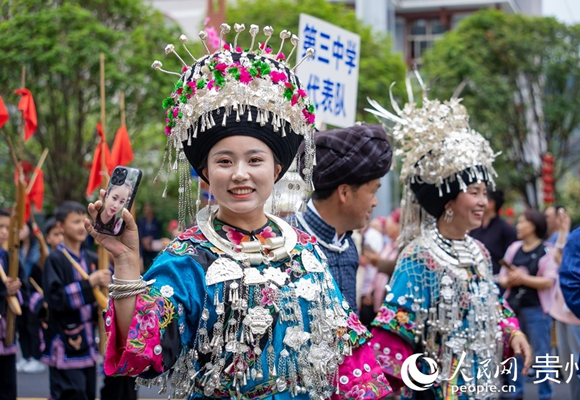Streams of Gold from Needles & Threads
The culture of an ethnic group is undergoing a revival that is also helping pull people from poverty.
When the 8.0 Wenchuan earthquake struck at 2.28 pm on May 12, 2008, sending ripples as far afield as Russia, Thailand and Taiwan, it was clear that any town or village not far from its epicenter was likely to be severely shaken and probably devastated as well.
One of those towns is about 150 kilometers northwest of Wenchuan in the mountainous Aba Tibetan and Qiang Autonomous Prefecture of Sichuan.
Only after days of frantic efforts to save lives could an accurate assessment of the quake's dreadful toll be made: nearly 87,000 people dead, 374,000 injured and nearly 18,000 missing, in addition, of course, to the thousands of buildings left in ruins.
Hidden in those raw figures is the devastation visited upon one of China's oldest ethnic groups, the Qiang. Not only did the quake literally decimate the Qiang, killing 20,000 of them, but it lay to waste precious Qiang culture, including hundreds of traditional buildings that were toppled and myriad cultural relics that were destroyed.
One of the 180,000 or so members of the Qiang ethnic group who survived was Zhang Juyue, 18 years old when the quake struck and a first-year student studying mechanical engineering at Chengdu Aeronautic Polytechnic.
The village in which Zhang was born and raised is in Xuecheng, an ancient town with a history that goes back to the Qing Dynasty (1644-1911), which is home to the Qiang and Tibetan ethnic people, most of whom live in mountainous or hilly areas. These rich assets make Xuecheng, despite its remoteness, a big tourist draw.
"Luckily, my family were safe even if our house was destroyed," says Zhang, 30.
The earthquake forced many Qiang ethnic people to leave the area to find work in cities, but Zhang eventually decided to take the journey in the opposite direction.
Five years after the earthquake and a few years after graduating from college, she quit her job as a public servant, and in 2014 she set up a cooperative in her hometown bringing local women together to make distinctive Qiang ethnic hand embroidery and sell it on the internet.
She named her online shop Xi Yue, meaning happiness. Though it was exactly this that her career change would bring her, when she made her decision it confounded many of her relatives and others in her hometown, many of whom have come to be believe that city life holds the promise of nirvana.
"Qiang ethnic people and embroidery are inextricably linked in their culture and throughout history, and I had been interested in the bright handcrafted Qiang cotton and silk works since when I was a child," Zhang says. "I was keen to let more people know about the great culture of the Qiang."
Zhang's mother is the leader of the village's women's federation and helped local women to sell their embroidery products.
"The Qiang people have no written language, so the Qiang embroidery is carried forward only by hand and word of mouth," Zhang says.
With her online shop on Taobao and promoting the handcrafted embroidery products via social media platforms, Zhang steadily gained a following, especially among young buyers who like to put embroidered patterns to use in clothing, bags and accessories.
"Many Qiang women make embroidery for their own use and are unaware of how they can turn their handicrafts into commercial products," Zhang says. "Many of those who are, and who have never left their village see their products travel to different parts of the country and even throughout the world."
Having learned to do embroidery herself, she feels she can better present and explain products to customers. She also conducts workshops training local women so they can join the cooperative. She now works with about 120 Qiang women from 30 to 70 years old, who turn Qiang embroidery into items that fit contemporary life.
Zhang says she receives orders from all over China. The women of her cooperative produce every day based on the size and pattern of the embroidery products, and they can earn between 500 yuan ($70) and 3,000 yuan a month.
In addition to making embroidery products, villagers make a living by growing vegetables and raising livestock. The average income of the villagers is from 2,000 yuan to 3,000 yuan.
"Some disabled women cannot do farm work," Zhang says.
"The cooperative gives them the opportunity to make embroidery products and to make money from them. The good thing is that they don't have to leave their families to work in cities, and the income they earn gives them better lives."
Making traditional handicrafts has become a source of income for local women, but turning the art into products for modern consumption remains a key challenge for Zhang. She now runs eight shops, including four cooperative shops, across the country, to increase individual sales.
One of her most popular products is a cell phone case with flowery patterns inspired by the Qiang ethic group, such as rhododendrons, commonly seen in Zhang's village, and rhombus-shaped patches with thread of red, green and white, symbolizing passion for life, for nature and for good spirits.
Now Zhang, who gave birth to her first child five months ago, plans to take Qiang embroidery to primary and middle schools, aiming to raise awareness of Qiang traditional culture and to make Qiang embroidery sustainable.
(Source: China Daily)
Please understand that womenofchina.cn,a non-profit, information-communication website, cannot reach every writer before using articles and images. For copyright issues, please contact us by emailing: website@womenofchina.cn. The articles published and opinions expressed on this website represent the opinions of writers and are not necessarily shared by womenofchina.cn.







 WeChat
WeChat Weibo
Weibo 京公网安备 11010102004314号
京公网安备 11010102004314号